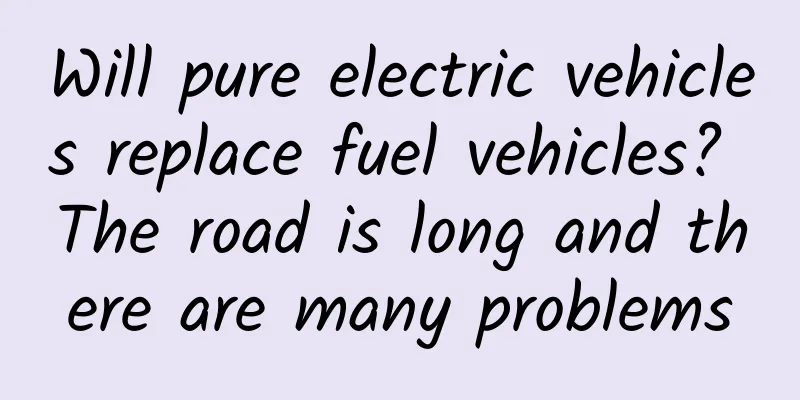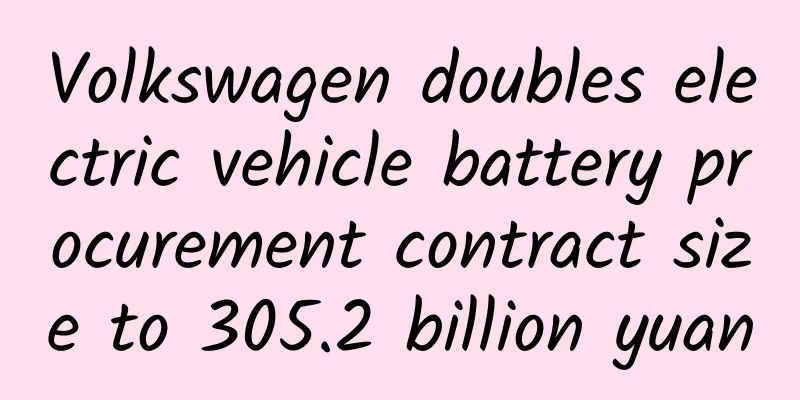Will pure electric vehicles replace fuel vehicles? The road is long and there are many problems

|
In 2017, global electric passenger car sales exceeded 1.223 million units, a year-on-year increase of 58%. This is the first time that global electric passenger car sales have exceeded 1 million units. At the same time, electric vehicle sales accounted for more than 1% of the total global auto market sales in 2017. China's electric vehicle industry is developing faster. In 2017, the total sales volume of new energy vehicles in my country reached 777,000 units, a year-on-year increase of 53%. In 2017, the penetration rate of electric passenger vehicles in China was about 2%, higher than the global average. China plans to reach a production capacity of 2 million pure electric vehicles and plug-in hybrid vehicles and a cumulative production and sales volume of more than 5 million vehicles by 2020. In addition, China will completely ban the sale of fuel vehicles by 2035. It seems that pure electric vehicles will completely replace fuel vehicles. Dreams are beautiful, but we must eventually face the cruel reality. Policy is still the main driver of electric vehicles China has made good achievements in the field of new energy vehicles, especially electric vehicles. However, it must be noted that the rapid development of electric vehicles in recent years is not driven by the market, but by policies. In first-tier cities like Beijing, many people buy electric cars mainly for a license plate. One of the important reasons why car companies are focusing on electric vehicles is the guidance of subsidies. Some car companies even launched electric vehicles specifically to defraud subsidies. Considering the high price of electric vehicles, poor battery life, troublesome charging process, and terrible depreciation rate, most electric vehicles are not yet competitive in the market compared to traditional fuel vehicles. Without subsidies and license benefits, most people would not even consider pure electric vehicles. At present, many car companies claim that their pure electric vehicles have a range of 400 or even 500 kilometers. But in reality, they can only run 200 to 300 kilometers. Compared with fuel vehicles that can easily run 700 to 800 kilometers with a full tank of gas, it is not good enough. Recently, a NIO owner revealed that the NIO ES8, which claims to have a range of 355 kilometers, actually has a high-speed range of only 178km. Since electric cars are so poor in terms of battery life, why does the country provide strong subsidies to support them? Energy security is an important factor in China's support for the development of the new energy vehicle industry. my country is seriously short of oil resources, and most of the oil is imported. However, my country now has a very large number of cars. It is expected that by 2021-2022, China will surpass the United States and become the world's largest automobile country. If my country can gradually replace fuel vehicles with pure electric vehicles, it will significantly reduce oil consumption, thereby reducing crude oil imports and ensuring national energy security. In fact, not only China, but also Japan, South Korea and Europe have energy security considerations in developing new energy vehicles. The United States itself is rich in oil resources and has a strong influence on other oil-producing countries. Although the United States has industry benchmarks such as Tesla, it is much colder towards the new energy vehicle industry than China, Europe, Japan and South Korea. The development of China's automobile industry has long lagged behind that of foreign countries. Joint ventures gave up the market but did not gain technology in return. Although domestic brands have achieved certain results, they are still not enough to catch up. As a substitute for fuel vehicles, new energy vehicles have the same starting line, which gives China the opportunity to overtake others. For both the country and enterprises, new energy vehicles are an opportunity that cannot be missed. There has been a lot of discussion about whether new energy vehicles are environmentally friendly. Most of the electricity for China's electric vehicles comes from thermal power. Electric vehicles themselves do not produce pollution, but they simply transfer the original automobile exhaust pollution to thermal power generation, which is not environmentally friendly overall. Moreover, if the battery is not handled properly, it will cause further pollution. However, electric vehicles have turned dispersed pollution into centralized emissions. Although this is only a temporary solution, it provides an opportunity to deal with pollution in a centralized and efficient manner. After all, the cost of treating pollution from thermal power plants is much lower than that of solving automobile exhaust pollution. The heart disease of electric vehicles It can be said that insufficient battery life is the biggest bottleneck in the development of electric vehicles. The improvement of electric vehicle battery life depends on the improvement of battery energy density. However, the energy density of power batteries is still a matter of concern. Judging from the current energy density of power batteries, it is difficult to catch up with fuel vehicles, let alone surpass them. Batteries are not a new technology. Rechargeable chemical batteries were invented in the mid-19th century, more than 160 years ago. The chemical principle of power batteries is essentially still a redox reaction, which requires an oxidant and a reductant. Fuel vehicles only need to load fuel as a reductant and can directly use the oxidant in the air - oxygen. Batteries cannot use oxygen, so they must have their own oxidant. This most basic technical principle determines that the energy density of batteries is difficult to surpass fuel. Moreover, the electrochemical redox reaction of the battery is far less intense than the combustion redox reaction of the fuel, which also limits the energy density of the battery. In the current electrochemical system, the energy density of batteries has an upper limit in theory, and current efforts are only approaching this limit. The various limitations of battery technology principles actually determine that it is difficult for electric vehicles to surpass fuel vehicles in terms of range. There is also the problem of short battery life. The basic chemical principle of the electrochemical reaction process determines that the reducing agent cannot be completely reduced during each cycle. After a certain number of years of use, the battery's performance will inevitably decline. The electrochemical reaction process is significantly affected by temperature, and low temperatures will significantly reduce its efficiency. As a result, the performance of electric vehicles will drop significantly in winter. Improving materials and processes can improve this phenomenon, but it is impossible to fundamentally solve it. Although electric vehicles have the advantage of energy saving when driving at low speeds and with frequent starts and stops, their range will be further reduced when driving at high speeds. High-speed range is the weak point of electric vehicles, and this problem is not only faced by domestic electric vehicles, but also by Tesla. How to cure the problem of endurance? Since batteries cannot fundamentally replace fuel due to reasons such as energy density, the combination of batteries and fuel is a good choice. Hybrid technology combines the advantages of both pure electric vehicles and fuel vehicles. The battery capacity does not need to be large, which can effectively reduce the consumption of oil resources and eliminate worries about cruising range. In Europe and Japan, plug-in hybrid vehicles dominate new energy vehicles. In the United States, the proportion of pure electric and plug-in hybrid vehicles is relatively balanced. Unlike other countries, the proportion of pure electric passenger cars in China's new energy passenger cars exceeds 80%. In 2017, my country's total sales of new energy vehicles reached 777,000 units, of which 652,000 were pure electric and 125,000 were plug-in hybrid. Even if electric vehicle technology is fully developed in the future, electric vehicles are still not competent in many scenarios. For example, in relatively cold areas, such as areas where infrastructure construction is very backward and charging stations are seriously insufficient. Electric vehicles and fuel vehicles can play their respective roles in scenarios that better meet market demand. China's policy support is more inclined towards electric vehicles, which is in line with the long-term development trend. However, it is safer in the short term to not give up the policy support for hybrid vehicles. Electric and fuel are not completely opposite, and the advantages of electric can be better utilized when combined with internal combustion engines. However, hybrid is ultimately a transitional form. The high proportion of electric vehicles replacing fuel vehicles requires the improvement of various supporting facilities and technologies. The first is the construction of various charging infrastructure. In addition to the battery life, the main complaint about electric vehicles is that there are no charging stations. As a kind of infrastructure, the improvement of charging equipment cannot rely solely on the efforts of related enterprises. The construction of such infrastructure cannot be achieved overnight, and long-term planning and construction are required at the national level. For areas with sparse population, meager profits, and capital unwilling to touch, the government should follow up in a timely manner. Electric vehicle charging not only involves charging stations and charging piles, but also poses new challenges to the national power grid. The large-scale use of electric vehicles will inevitably put great pressure on the power grid. The progress of the national power grid is also an important foundation for the development of electric vehicles. The construction of charging facilities and the upgrading of power grids require long-term efforts, which also determines that electric vehicles cannot quickly replace fuel vehicles. When charging becomes as convenient as refueling, people’s anxiety about the range of electric vehicles will decrease, and the market demand for electric vehicles will be naturally released. Mobile phone batteries also have the problem of low energy density and short battery life. Mobile phone manufacturers have indirectly "extended" the battery life of mobile phones by using fast charging technology to save the country. If electric vehicles can be charged faster, it will actually alleviate the anxiety of battery life. Compared to fuel vehicles that can be filled up in a few minutes, charging electric vehicles is very troublesome. Slow charging takes more than six hours and fast charging takes about 40 minutes. At present, some manufacturers claim that their fast charging can fully charge 80% of the battery in just over ten minutes. It sounds like the pain point of charging speed has been solved. However, charging speed is not the only indicator. One-sided emphasis on charging speed will reduce battery life, affect battery life, and even cause safety hazards. Advances in charging technology also affect whether electric vehicles can become more popular. In fact, whether it is a mobile phone or a car, the extensive use of fast charging will have a negative impact on the battery. However, the cost of mobile phone batteries is low, and mobile phones are updated very quickly, so this damage can be accepted. However, cars generally require a service life of about ten years, and power batteries are very expensive. Extensive use of fast charging is not suitable for electric vehicles. Since charging is too slow, some companies are betting on battery swapping technology. Tesla tried it earlier, but eventually gave up because the cost was too high. Currently, BAIC and NIO are both trying this technology path. However, the prospects for this technology are not optimistic. The reason is that battery swapping requires the unification of battery specifications. The technical indicators of batteries are the most critical and core part of pure electric vehicles, involving the core interests of every car company, and it is difficult to unify them. Moreover, if batteries are developed and manufactured by a monopoly company, market competition will be eliminated, and the most critical and core part of pure electric vehicles will lose the driving force for technological progress. For a single enterprise, the cost of building a battery swap station system alone is too high to be acceptable. In fact, there is a price to pay for unifying battery specifications within a car company. For example, as a high-end model, the NIO ES8 should be equipped with a battery with a higher energy density, but in order to achieve unified battery replacement in the future, it can only take low-end models into consideration and use low-density batteries, resulting in much inferior battery life. It is not possible to say now that the battery swap model has no future. But one thing is certain, the large-scale promotion of the battery swap model is inseparable from the unified planning of the country; and in order to ensure that market competition promotes technological development, it is necessary to wait until electric vehicle technology is mature enough. Electrification is still the future of the automotive industry Although electric vehicles face many development bottlenecks, electrification remains the future of the automotive industry. This is not only because of the various advantages of electric vehicles over fuel vehicles, such as fast starting, low driving noise, and no exhaust emissions; more importantly, electric vehicles are in line with the future of the automotive industry. There is no doubt that the trend of automobile intelligence is unstoppable. Unlike new energy vehicles, which are merely improvements on the power system of fuel vehicles, intelligent vehicles are a comprehensive and thorough transformation of traditional mechanical vehicles. The development of intelligent cars means that the degree of electronicization of cars will become higher and higher. However, fuel vehicles are not very friendly to electronic equipment. The power output of fuel vehicles will release a lot of heat and vibration waves, which has a great impact on electronic components and semiconductors. At the same time, the electrical energy used by fuel vehicles needs to be converted into kinetic energy for the second time, which will not only cause energy loss, but also cause power transmission fluctuations, which is not conducive to providing a stable working environment for electronic components. With the increasing electronicization and intelligence of automobiles, in the automotive aftermarket, electronic unit failures of fuel vehicles have replaced mechanical failures as the most common type of failure. Pure electric vehicles are the best carriers of automotive intelligence. The battery has an independent cooling system; the motor is much better than the internal combustion engine in terms of balance. Moreover, the battery directly supplies power, so there is no problem of unstable power transmission. The good compatibility of pure electric vehicles and smart applications provides them with a broad future. If fuel vehicles are replaced by electric vehicles in the future, it will not be because their mechanical performance is inferior to that of electric vehicles, but because they are forced to fade out of the mainstream due to the trend of intelligence. Electric motors are also better suited for autonomous driving. Autonomous driving technology is difficult to implement and has very high safety requirements. The easy-to-control characteristics of motors can reduce the difficulty of autonomous driving technology and are also better in ensuring safety. Although some fuel vehicles are already equipped with partial autonomous driving functions, the vast majority of autonomous driving technology is currently being developed in conjunction with electric vehicles. Electric vehicles and autonomous driving, two technologies that represent the future, are naturally integrated together. Judging from the trend of car sharing, electric vehicles also have better development prospects than fuel vehicles. In the traditional taxi industry, the labor cost of drivers can reach 50% to 70% of the total cost. The high labor cost has forced online car-hailing companies such as Uber and Didi Chuxing to step up their layout of driverless taxi business. Considering the high labor costs, car sharing must be combined with autonomous driving. Even if unmanned driving is not possible, technologies such as automatic pick-up and automatic parking can significantly reduce operating costs. For the fleets of shared cars and taxi companies, the endurance of electric vehicles is no longer a problem because they are managed in a unified manner and are mostly short-distance transportation within the city. Electric vehicles have cost advantages over fuel vehicles in terms of vehicle maintenance and repair, and electricity is cheaper than fuel. As far as the current situation is concerned, it is unrealistic for electric vehicles to achieve a high proportion of replacement for fuel vehicles in the short term. The arrival of the turning point in the electric vehicle market depends on the performance improvement brought about by technological breakthroughs, as well as the improvement of supporting facilities and technologies. It took more than a hundred years for the development of fuel vehicles to achieve today's results. The development of electric vehicles also requires time to accumulate. It is foreseeable that in the short term, electric vehicles will become the main supplement to the automobile market, accounting for a high proportion in scenarios such as second cars, cars used within campuses, shared transportation, and urban commuting. At present, the market share of electric vehicles is still very low. Even if they replace 20% of traditional vehicles, it is still a huge market. Electric vehicles are deeply integrated with the future of the automotive industry. We should pay enough attention to it, but we should not rush into it. As a winner of Toutiao's Qingyun Plan and Baijiahao's Bai+ Plan, the 2019 Baidu Digital Author of the Year, the Baijiahao's Most Popular Author in the Technology Field, the 2019 Sogou Technology and Culture Author, and the 2021 Baijiahao Quarterly Influential Creator, he has won many awards, including the 2013 Sohu Best Industry Media Person, the 2015 China New Media Entrepreneurship Competition Beijing Third Place, the 2015 Guangmang Experience Award, the 2015 China New Media Entrepreneurship Competition Finals Third Place, and the 2018 Baidu Dynamic Annual Powerful Celebrity. |
Recommend
Technology trends for 2015, etc. This alien feels like he's from Mars.
[[125812]] The new year has arrived. At this time...
The first release rules of major Android app markets in 2019
First release is a free promotion method in the a...
South Korea's Ministry of Land, Infrastructure and Transport: South Korea's new energy vehicle ownership exceeds 1 million
Data released by the Ministry of Land, Infrastruc...
“Activity Lottery”, how to achieve a growth of 50 million?
When it comes to lotteries, you may think of draw...
Outlook for China's strategic emerging industries in 2018: Emerging industries are an important force for economic growth
In 2018, the global emerging industries are expec...
A matrix strategy project with a monthly income of 20,000+, which even novices can easily get started with
I haven't written a project analysis article ...
Why are wetlands called the “Kidneys of the Earth”?
Did you know that wetlands only cover 6% of the E...
Early Star: Young Big Brother? Or the Other Half of the “Magic Star”?
Produced by: Science Popularization China Author:...
How to use zero-threshold oCPC delivery?
Baidu's zero-threshold oCPC has been online f...
8 ways to make your app icon stand out
The app icon plays a very important role in the c...
Super complete! A collection of information flow data analysis methods. With it, do you still have to worry about conversion?
Data analysis is difficult, as difficult as climb...
What’s so special about a football player’s dining table?
As the World Cup begins, more and more reports ar...
"Wang Baobao"'s new brand marketing methodology
In April 2020, Black Ant Capital led the investme...









